Magical Mesoamerican Relics
Mexico City, Mexico
January/February 2024
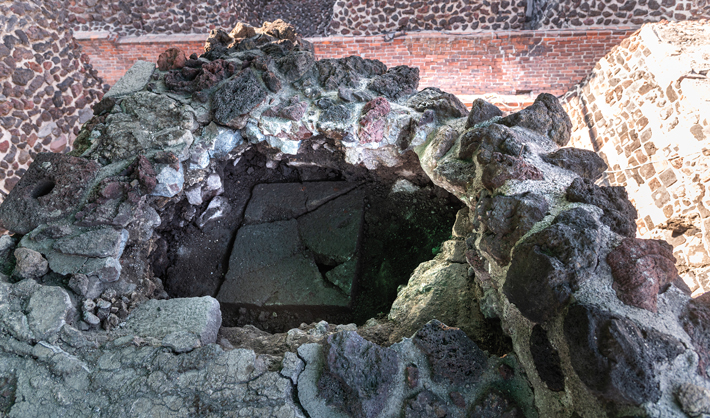
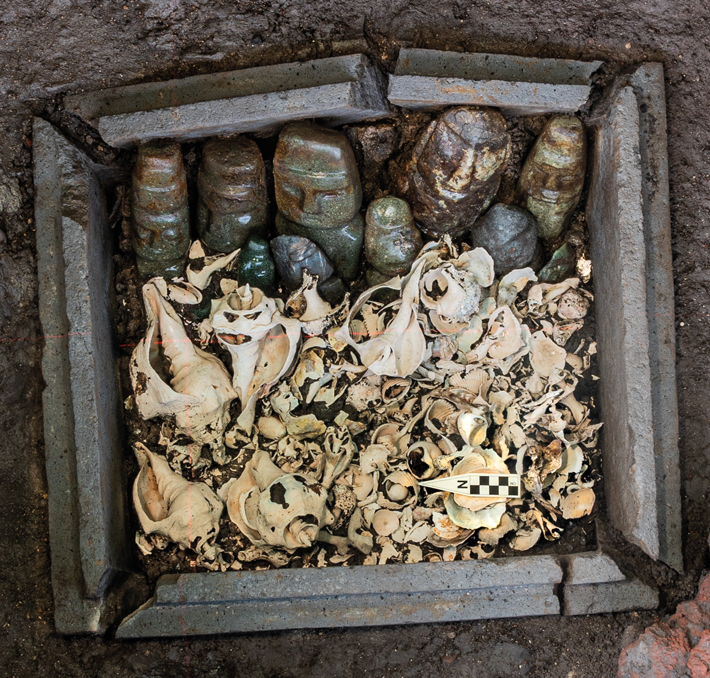 The Templo Mayor, including the massive pyramids at the heart of the Aztec, or Mexica, capital of Tenochtitlan, is like a Russian doll, says archaeologist Leonardo López Luján of Mexico’s National Institute of Anthropology and History. “When you dig within a Mesoamerican pyramid, you find another that is older and smaller,” he says. In the ninth of 13 total layers, López Luján and his team have uncovered a small chest made of volcanic stone that, like the Templo Mayor complex itself, contains many layers of meaning. Inside the chest, they found 15 perfectly preserved anthropomorphic figurines made of serpentine, along with Aztec symbols of water and fertility such as marine sand, a pair of rattlesnake-shaped scepters, hundreds of greenstone beads, and seashells, snails, and coral. The layer of the temple in which the chest was found dates to the year 1 Rabbit, or 1454, when, under Moctezuma I (reigned 1440–1469), the temple underwent one of its most impressive expansions. But the figurines were already 1,000 years old at the time and had been brought to Tenochtitlan from around 200 miles away.
The Templo Mayor, including the massive pyramids at the heart of the Aztec, or Mexica, capital of Tenochtitlan, is like a Russian doll, says archaeologist Leonardo López Luján of Mexico’s National Institute of Anthropology and History. “When you dig within a Mesoamerican pyramid, you find another that is older and smaller,” he says. In the ninth of 13 total layers, López Luján and his team have uncovered a small chest made of volcanic stone that, like the Templo Mayor complex itself, contains many layers of meaning. Inside the chest, they found 15 perfectly preserved anthropomorphic figurines made of serpentine, along with Aztec symbols of water and fertility such as marine sand, a pair of rattlesnake-shaped scepters, hundreds of greenstone beads, and seashells, snails, and coral. The layer of the temple in which the chest was found dates to the year 1 Rabbit, or 1454, when, under Moctezuma I (reigned 1440–1469), the temple underwent one of its most impressive expansions. But the figurines were already 1,000 years old at the time and had been brought to Tenochtitlan from around 200 miles away.
These types of figurines were typically produced from around 500 B.C. to A.D. 680 by the Mezcala people, who were based in an area that is now in the southwestern Mexican state of Guerrero. In their most sacred space, the Aztecs made the objects their own by embellishing them with paint and placing them in the chest as offerings to their rain god Tlaloc. “Tenochtitlan was the center of the Mesoamerican world,” says López Luján. Objects were brought from all of the provinces of the empire, and even beyond its borders. “The Mezcala figurines were considered by the Aztecs magical relics from the past,” he says. “Many of these offerings are cosmograms, or representations in miniature of the universe as conceived by the Aztecs. The chest and its contents symbolized a mythic realm known as Tlalocan which was re-created by Templo Mayor, where the rain god kept water and sustenance.”
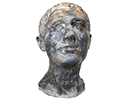
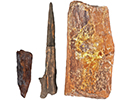
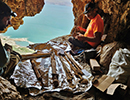
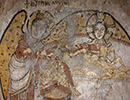
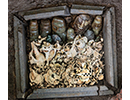
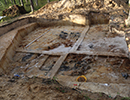
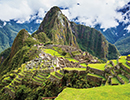
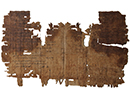
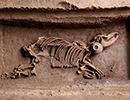
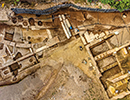
Advertisement
IN THIS ISSUE
Digs & Discoveries
When It Rains It Pours
A Courtesan’s Prized Possession
Maize Maintenance
Denmark’s Founding Mother
Tracking Ancient Animals
Ice Age Cannibalism
From Hunted to Herded
Divine Dreaming
Legionary Personal Effects
Portrait of an Ancient Ax
Off the Grid: Ambrosio Cave, Cuba
Artifact
Maya toy story
Advertisement

Recent Issues
-
 May/June 2024
May/June 2024
-
 March/April 2024
March/April 2024
-
 January/February 2024
January/February 2024
-
 November/December 2023
November/December 2023
-
 September/October 2023
September/October 2023
-
 July/August 2023
July/August 2023
-
 May/June 2023
May/June 2023
-
 March/April 2023
March/April 2023
-
 January/February 2023
January/February 2023
-
 November/December 2022
November/December 2022
-
 September/October 2022
September/October 2022
-
 July/August 2022
July/August 2022
-
 May/June 2022
May/June 2022
-
 March/April 2022
March/April 2022
-
 January/February 2022
January/February 2022
-
 November/December 2021
November/December 2021
-
 September/October 2021
September/October 2021
-
 July/August 2021
July/August 2021
-
 May/June 2021
May/June 2021
-
 March/April 2021
March/April 2021
-
 January/February 2021
January/February 2021
-
 November/December 2020
November/December 2020
-
 September/October 2020
September/October 2020
-
 July/August 2020
July/August 2020
-
 May/June 2020
May/June 2020
-
 March/April 2020
March/April 2020
-
 January/February 2020
January/February 2020
-
 November/December 2019
November/December 2019
-
 September/October 2019
September/October 2019
-
 July/August 2019
July/August 2019
-
 May/June 2019
May/June 2019
-
 March/April 2019
March/April 2019
-
 January/February 2019
January/February 2019
-
 November/December 2018
November/December 2018
-
 September/October 2018
September/October 2018
-
 July/August 2018
July/August 2018
-
 May/June 2018
May/June 2018
-
 March/April 2018
March/April 2018
-
 January/February 2018
January/February 2018
-
 November/December 2017
November/December 2017
-
 September/October 2017
September/October 2017
-
 July/August 2017
July/August 2017
-
 May/June 2017
May/June 2017
-
 March/April 2017
March/April 2017
-
 January/February 2017
January/February 2017
-
 November/December 2016
November/December 2016
-
 September/October 2016
September/October 2016
-
 July/August 2016
July/August 2016
-
 May/June 2016
May/June 2016
-
 March/April 2016
March/April 2016
-
 January/February 2016
January/February 2016
-
 November/December 2015
November/December 2015
-
 September/October 2015
September/October 2015
-
 July/August 2015
July/August 2015
-
 May/June 2015
May/June 2015
-
 March/April 2015
March/April 2015
-
 January/February 2015
January/February 2015
-
 November/December 2014
November/December 2014
-
 September/October 2014
September/October 2014
-
 July/August 2014
July/August 2014
-
 May/June 2014
May/June 2014
-
 March/April 2014
March/April 2014
-
 January/February 2014
January/February 2014
-
 November/December 2013
November/December 2013
-
 September/October 2013
September/October 2013
-
 July/August 2013
July/August 2013
-
 May/June 2013
May/June 2013
-
 March/April 2013
March/April 2013
-
 January/February 2013
January/February 2013
-
 November/December 2012
November/December 2012
-
 September/October 2012
September/October 2012
-
 July/August 2012
July/August 2012
-
 May/June 2012
May/June 2012
-
 March/April 2012
March/April 2012
-
 January/February 2012
January/February 2012
-
 November/December 2011
November/December 2011
-
 September/October 2011
September/October 2011
-
 July/August 2011
July/August 2011
-
 May/June 2011
May/June 2011
-
 March/April 2011
March/April 2011
-
 January/February 2011
January/February 2011
Advertisement






